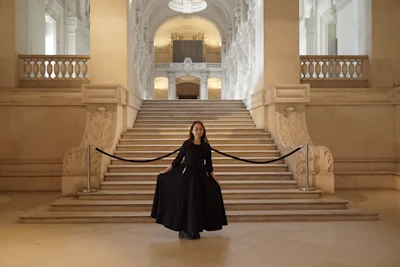12.24WED
Relay Column: The World & History Connected by the Warp & Weft of Ikat: From India to Marie Antoinette & the Modern Day (Kumi Eguchi)

PROFILE

Kumi Eguchi
Ph.D. in Engineering. Researcher at the Kyushu Open University, General Incorporated Association. Specially Appointed Assistant Professor at the Institute of Decision Science for a Sustainable Society, Kyushu University. Researches urban engineering and design studies. Major works include "パリの歴史的建造物保全" (Chuo Koron Bijutsu Shuppan). Co-authored works include "蜘蛛の巣上の無明:インターネット時代の身心知の刷新にむけて" (Kachosha), "〈キャラクター〉の大衆文化:伝承・芸能・世界" (KADOKAWA), and "映しと移ろい:文化伝播の器と蝕変の実相" (Kachosha), among others.
Inquiring ChatGPT About Fashion & Technology
What comes to mind when you hear the keywords fashion and technology? To explore this theme, I first asked ChatGPT, the latest technology, what it could suggest regarding fashion and technology. It provided intriguing responses such as "smart wear," "fashion VR/AR," "flexible displays," "movable materials," "smart textiles," "digital fashion," "sustainable fashion," and "AI-assisted fashion design." While I will refrain from elaborating on each point here, what connects them is that they all reflect cutting-edge technology and ideas, showcasing possibilities for future fashion. It would not be an exaggeration to say that fashion continues to evolve alongside technology.While it seems recent that fashion has become possible through technology, traditional crafts, which have been inherited for generations, also utilized the cutting-edge "technology" of their time, resulting in textiles that have continued to the present day. One such example is "kasuri," known outside of Japan as "ikat."
This article is for members only.
Please register to read the rest of the article.
What you can do with a membership
- Read members-only articles
and use text-to-speech. - Unlimited article favourites
and browsing history. - Attend members-only events.
- Get the latest information
with our email newsletter.
CONCEPT VIDEO
"fashion tech news" Unveils New Logo & Concept Video
TOP ARTICLES
RELATED ARTICLES
CONCEPT VIDEO
"fashion tech news" Unveils New Logo & Concept Video
CONTACT
If you have any questions or enquiries, please enter your details in the form below.








.jpg?w=400&fm=webp)

.jpeg?w=400&fm=webp)







.png?w=400&fm=webp)


